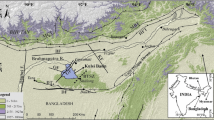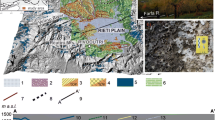Abstract
The Luni river basin has been evolved as a result of typical hydrogeomorphic processes of arid zone, operating under the influence of active tectonic lineaments. A detailed analysis of stream morphology in relation to geology and lineaments carried out on selected windows indicated the morphological control of the streams while flowing over the lineaments from the eastern to the western part of the basin. Typical valley fills indicated by dark green tone on digitally processed images and the pediments showing greenish white tone appear in sharp contrast and indicate respectively the graben and horst structures. A detailed identification of lineaments for the georesources and geological evaluation has been carried out. Earlier analysis carried out on Bouguer anomalies correlate with graben and horst structures in the subsurface. Quaternary sequences have been dated from 80 ka to 3 ka indicating a range of fluvial to aeolian deposits reflecting prevailing climatic conditions. However, the changes in sediment type from coarse and mixed of all size grades to fine in a vertical litho-column warrant further studies on fine resolution stratigraphy and high resolution stratigraphy for understanding climatic variations in the region
Similar content being viewed by others
References
Abdullatif O M 1989 Channel—fill and sheet—flood facies sequences in the ephemeral terminal River Gash, Kassala, Sudan;Sedimentary Geology 63 171–184
Bajpai V N and Fallah Pour T M 1998 Lineament mapping on satellite images for deciphering hydrogeologic situation in Banas river basin, Rajasthan, India. In:Remote Sensing in Geosciences Tripathi, N K and Bajpai, V N (eds), pp. 283–300. (New Delhi: Anmol publication) 300 pp
Bajpai V N Saha Roy T K and Tandon S K (2001a) Subsurface sediment accumulation patterns and their relationships with tectonic lineaments in the semi-arid Luni river basin, Rajasthan, Western India;Journal of Arid environments 48 603–621
Bajpai V N Saha Roy T K and Tandon S K 2001b. Hydrogeomorphic mapping on satellite images for deciphering regional aquifer distribution: case study from Luni river basin, Thar Desert, Rajasthan, India; Proceedings—International Conference on regional aquifer systems in arid zones—managing non-renewable resources. Tripoli, Libya, 20–24 November 1999, pp. 45–58
Bakliwal P C and Wadhawan S K 2003 Geological evolution of Thar desert in India—Issues and prospects;Proc. Ind. Nat. Sci. Acad. 69A(2) 151–165
Bell F C 1979. Precipitation. In: Goodall D W and Perry R A (eds), vol. 1, pp. 373–392. (London:Arid land ecosystems Cambridge University Press) 881 pp
Burnett A W and Schumm S A 1983 Alluvial—river response to neotectonic deformation in Louisiana and Mississippi;Science 222 49–50
Das Gupta S K and Chandra M 1978 Tectonic elements of the West Rajasthan Shelf and their stratigraphy;Quarterly Journal of the Geological, Mining and Metallurgical Society of India 50 1–16
Dhir R P, Kar A, Wadhawan S K, Rajaguru S N, Misra V N, Singhvi A K and Sharma S B 1992. Lineaments, In: Singhvi,Thar Desert in Rajasthan: land, man and environment, A.K. and Kar, A. (eds), pp 29–32. (Bangalore: Geological Society of India.) 191 pp
Enzel Y, Ely L, Mishra S, Ramesh R, Amit R, Lazar B, Rajguru S N, Baker V RSandler A 1999. High—resolution Holocene environmental changes in the Thar desert, northwestern India;Science 284 124–128
Goudie A and Wilkinson J 1977The warm desert environment. (London: Cambridge University Press) 80 pp
GSI (Geological Survey of India) 1976Atlas of Rajasthan: Geology and Minerals. (Jaipur: Geological survey of India)
GSI (Geological Survey of India) 1982Tectonic map of South and East Asia, (1st Edn.) (Hyderabad: Geological Survey of India)
Gupta S N, Arora Y K, Mathur R K, Iqbaluddin, Parsad B, Sohai T N and Sharma S B 1980Lithostratigraphic map of Aravalli region: Southern Rajasthan and Northern Gujrat. (Geological Survey of India)
Henry A, Saktawat U S and Paliwal B L 1983 Groundwater resources of Jalor district, Part 1, Hydrogeology; Groundwater department, Pali: Govt. of Rajasthan
Heron A M 1917 Geology of Northeastern Rajputana and adjacent districts;Mem. Geol. Surv. India,45 pt.1, pp. 1–128
Jain M; Tandon S K; Bhatt S C Singhvi A K and Mishra S 1999 Alluvial and aeolian sequences along the river Luni, Barmer district; physical stratigraphy and feasibility of luminescence chronology methods, pp. 273–295. In:Vedic Saraswati—Evolutionary history of lost river in north-western India. Memoir, Radakrishna B P and Merh, S.S (eds)42 329 pp
Jain M and Tandon S K 2003 Fluvial response to Late Quaternary climate changes, western India;Quaternary Science Reviews,22: 2223–2235
Jain M, Tandon S K, Singhvi A K, Mishra S, Bhatt S C, 2003 Quaternary alluvial stratigraphic development in desert river: A case study from the western India; 7th International Conference on Fluvial Sedimentology 2001, Lincoln, Nebraska, Proceeding volume, in press.
Jones K R 1981Arid Zone Hydrology Rome: Food and Agricultural Organization of the United Nations. 272 pp
Kar A 1992 Geomorphology of the Thar Desert in Rajasthan. In: Sharma H S and Sharma M L (eds),Geographical Facets of Rajasthan, pp. 298–314, Ajmer: Kuldeep Publications.
Kar A 1994 Lineament control on channel behaviour during the 1990 flood in the southeastern Thar Desert;International Journal of Remote Sensing,15 2521–2530
Kar A, 1999 A hitherto unknown palaeodrainage system from the radar imagery of southeastern Thar desert and its significance;Memoir Geological Society of India, No.42 229–235 p
Laronne J B and Reid I 1993 Very high rates of bedload sediment transport by ephemeral desert rivers;Nature 366 148–150
Mishra S, Jain M, Tandon S K, Singhvi A K, Joglekar P P, Bhatt S C, Kshirsagar A, Naik S and Mukherjee 1999 Prehistoric Cultures and Late Quaternary environments in the Luni basin around Balotra;Man and Environment 24 (1), 38–49
Mishra S and Rajaguru S N 2001 Late Quaternary Palaeoclimates of Western India: A Geoarchaeological Approach;Mausam 52: 285
Ouchi S 1985 Response of alluvial rivers to slow active tectonic movement;Geol. Soc. Am. Bull. 96 504–515
Pareek H S 1981 Basin configuration and sedimentary stratigraphy of Western Rajasthan;J. Geol. Soc. India,22: 517–527
Pareek H S 1984 Pre-Quaternary geology and mineral resources of northwestern Rajasthan;Memoir Geological Survey of India 115 1–99
Pal G N 1991 Quaternary landscape and morphostratigraphy in the lower reaches of the Luni basin. In:Proceedings of Quaternary landscape of Indian Subcontinent, Desai N, Ganpathi S and Patel R K (eds), pp 79–90. Vadodra, Geology Department, M.S. University, Baroda.
Pilgrim D H, Chapman T C and Doran D G 1988 Problems of rainfall—runoff modeling in arid and semi-arid regions.Hydrological Sciences Journal, 33 379–400
Ramasamy S M, Bakliwal P C and Verma R P 1991 Remote Sensing and river migration in western India;International Journal of remote Sensing,12 2597–2609
Reid I and Frostick L E 1987 Flow dynamics and suspended sediment properties in arid zone flash floods;Hydrological Processes, 1: 239–253
Roy A B and Jakhar S R 2001 Late Quaternary drainage disorganisation and migration and extinction of the Vedic Saraswati;Current Science,81 1188–1195
Roy B C 1959 The economic geology and mineral resources of Rajasthan and Ajmer;Geological Survey of India 86 386 pp
Sabins F 1987Remote Sensing: Principles and Interpretations. (San Francisco: W.H. Freeman & Company.) 426 pp
Sareen B K 2003 Quaternary stratigraphy of North Gujarat alluvial plains and interpretation of neotectonic evidences—a review;Proc. IV S. Asia Geol. Cong. (GEOSAS IV) 51–63
Sharma K D and Chatterji P C 1982 Sedimentation in Nadis in the Indian arid zone;Hydrological Sciences Journal 27 345–352
Sharma K D, Vangani N S, Choudhari J S, 1984 Sediment transport characteristics of the desert streams in India;Journal of Hydrology 67 261–272
Wadhawan S K, Sareen B K, Pal N K and Raghav K S 1999 Geological and geoenvironmental evaluation of the Thar desert, Rajasthan and Gujarat;Rec. Geol. Surv. India 129(7) 67–69
Wheater H S 2002 Hydrological processes in arid and semiarid areas. In:Hydrology of Wadi Systems. H S wheater and R A Al-Weshah (eds) UNSCO IHP-V Technical Documents in Hydrology55 pp. 5–22
Author information
Authors and Affiliations
Rights and permissions
About this article
Cite this article
Bajpai, V.N. Hydrogeological evolution of the Luni river basin, Rajasthan, western India: A review. J Earth Syst Sci 113, 427–451 (2004). https://doi.org/10.1007/BF02716735
Issue Date:
DOI: https://doi.org/10.1007/BF02716735




